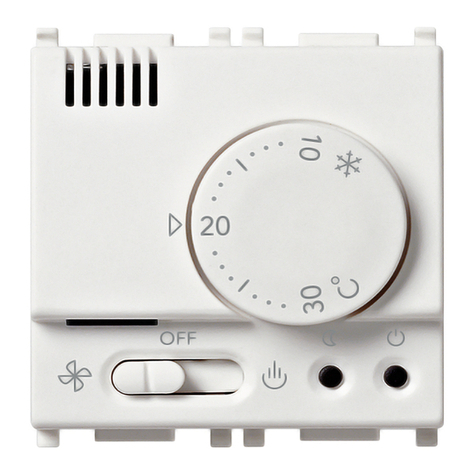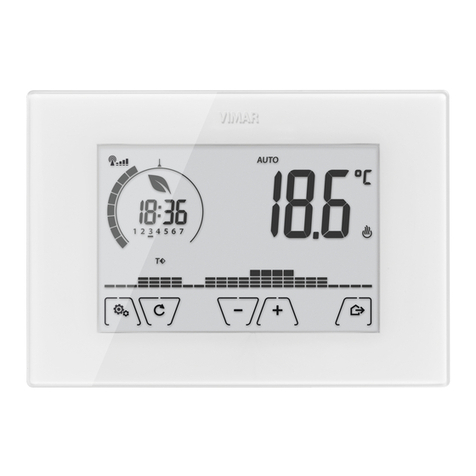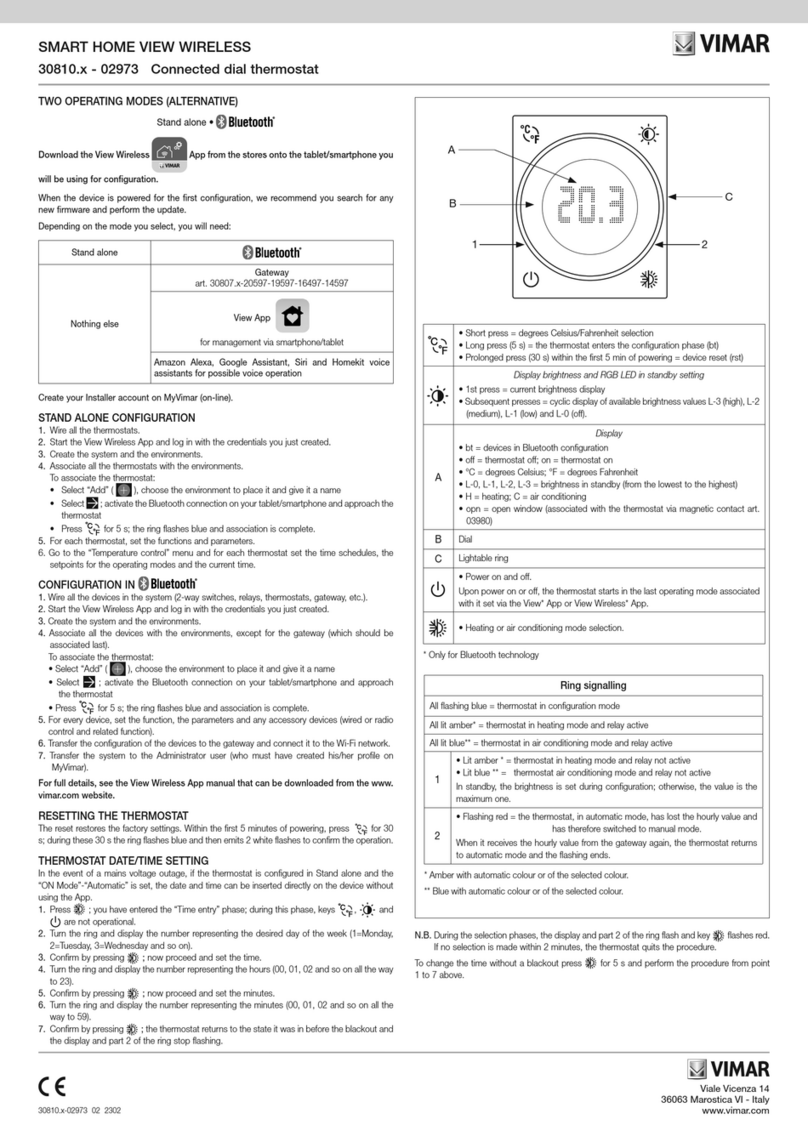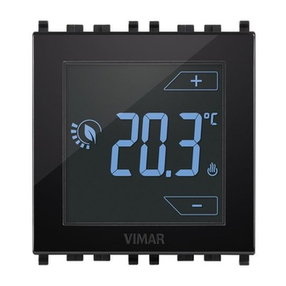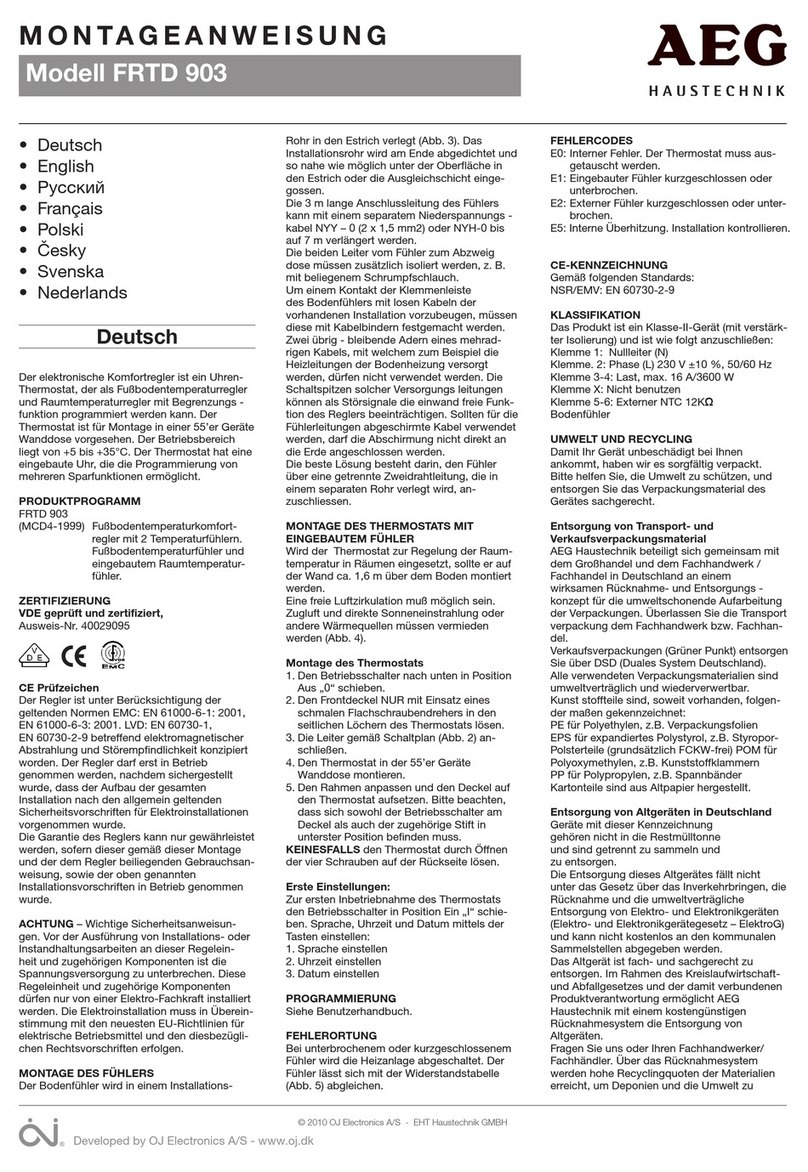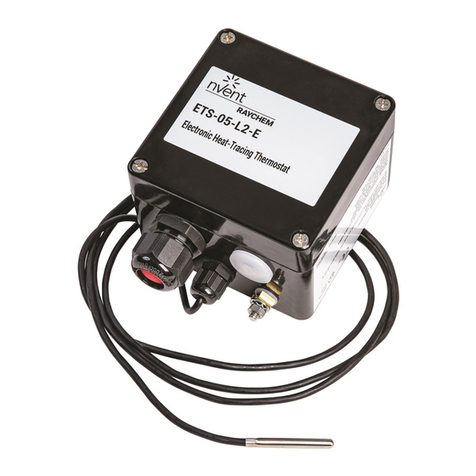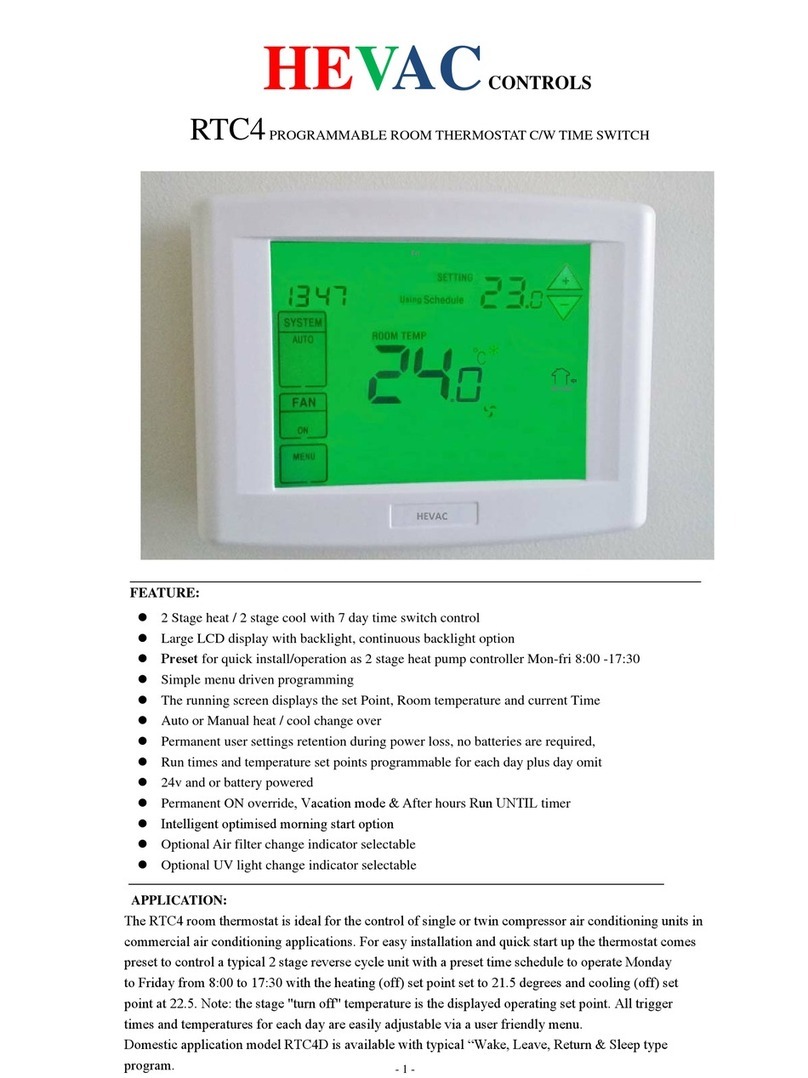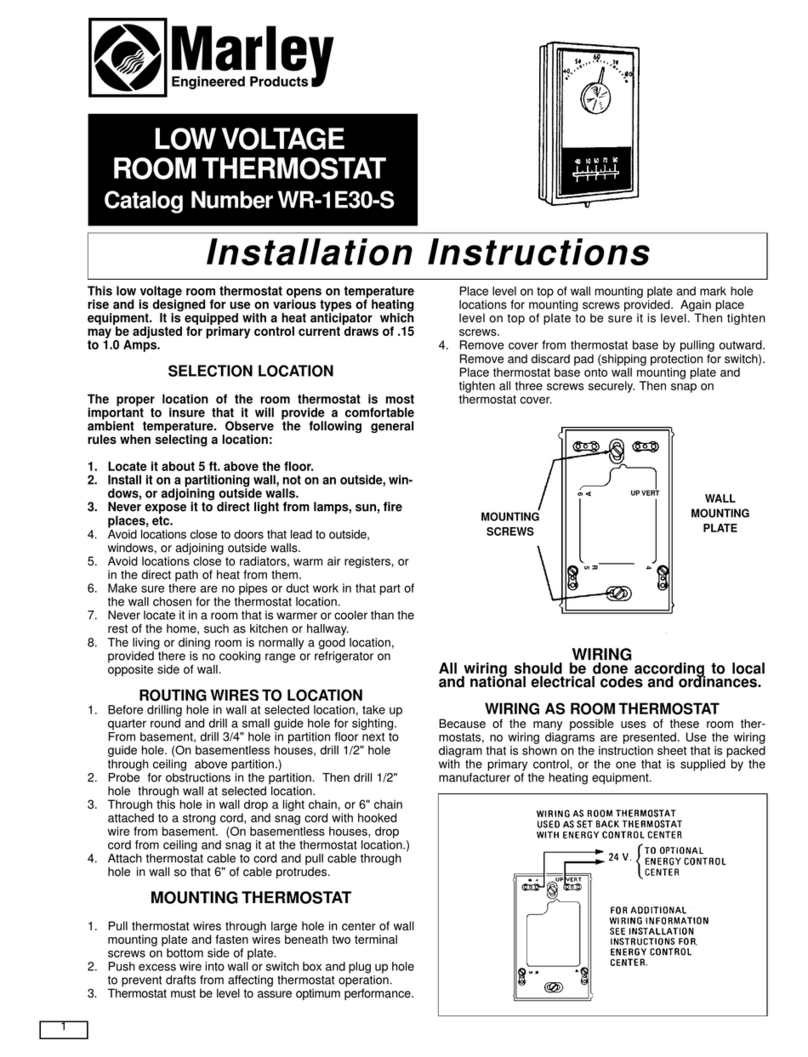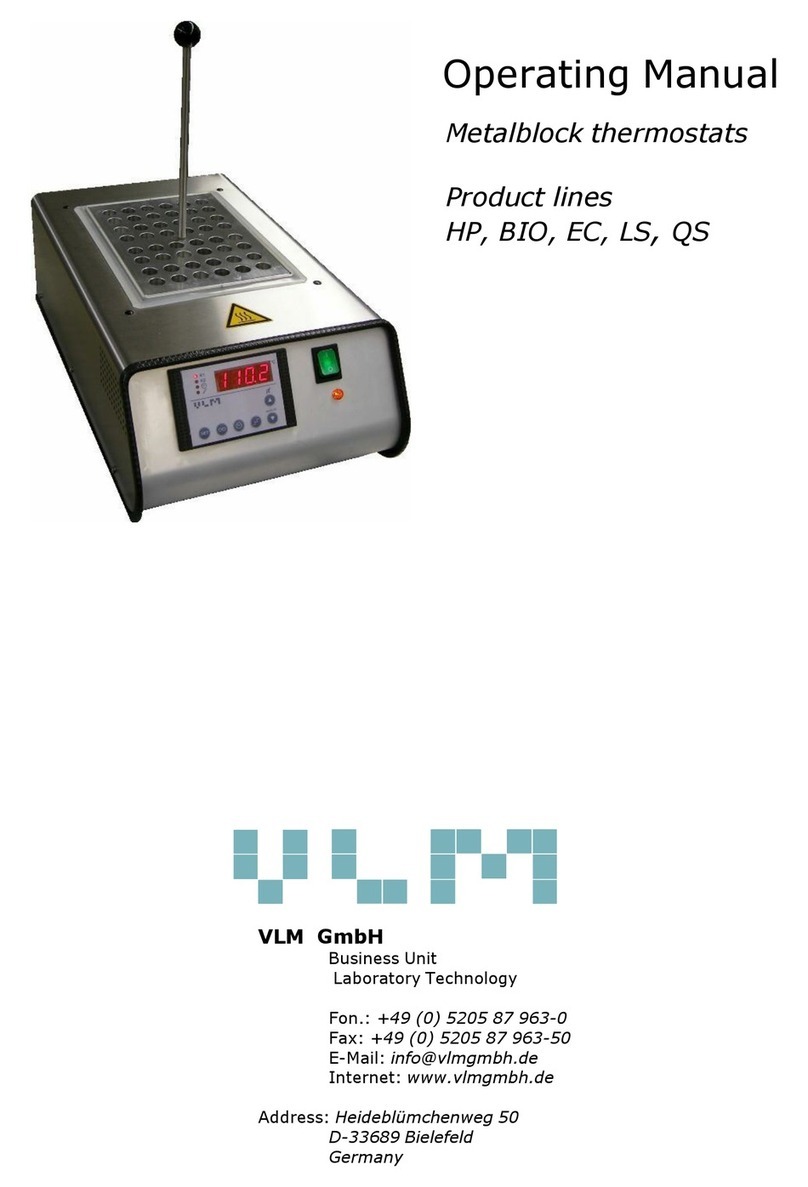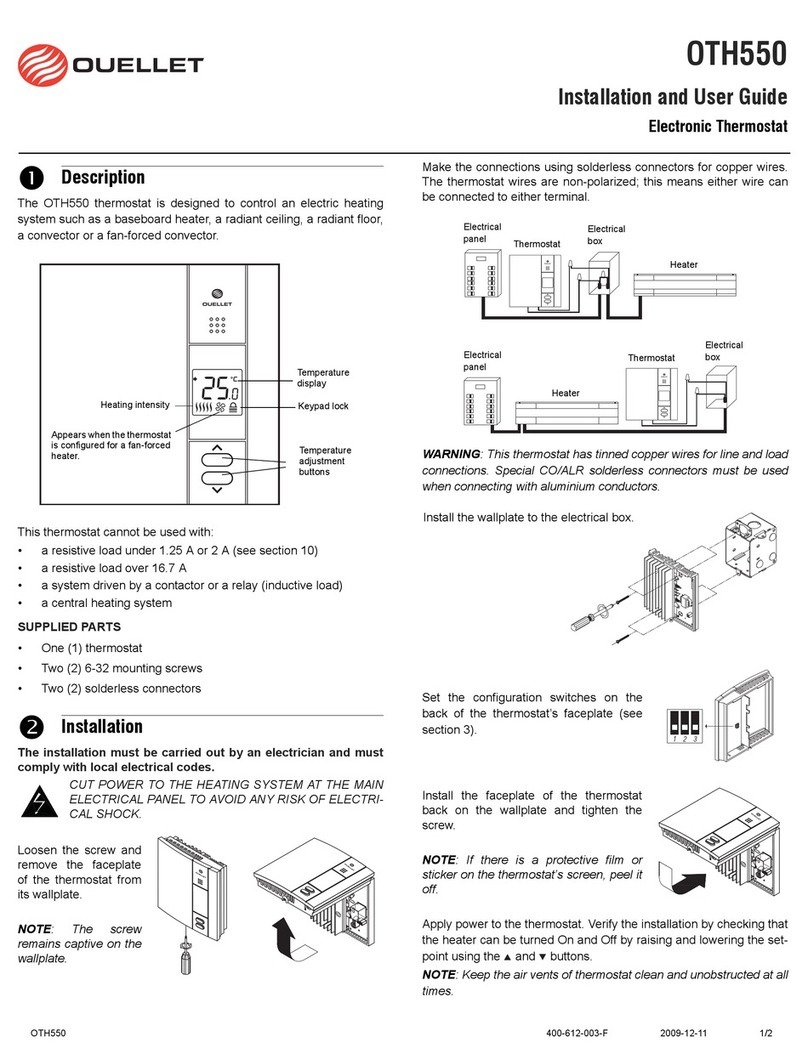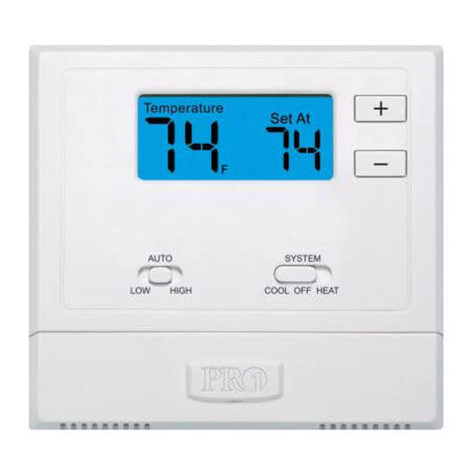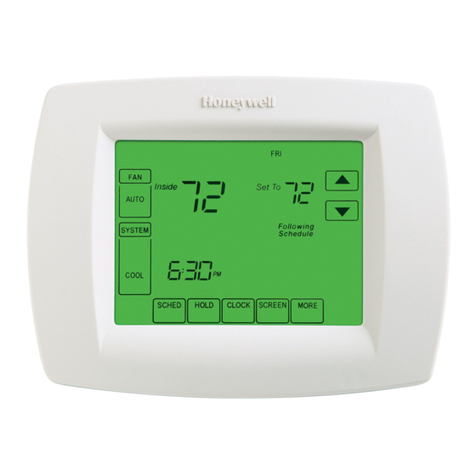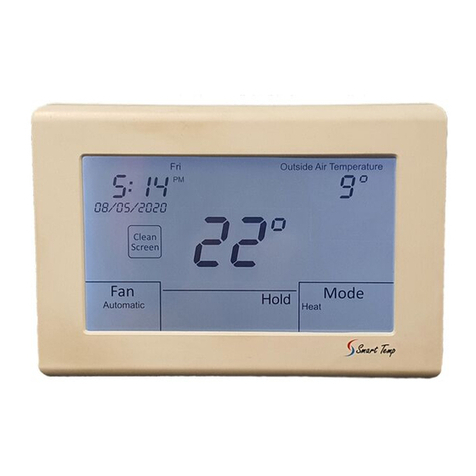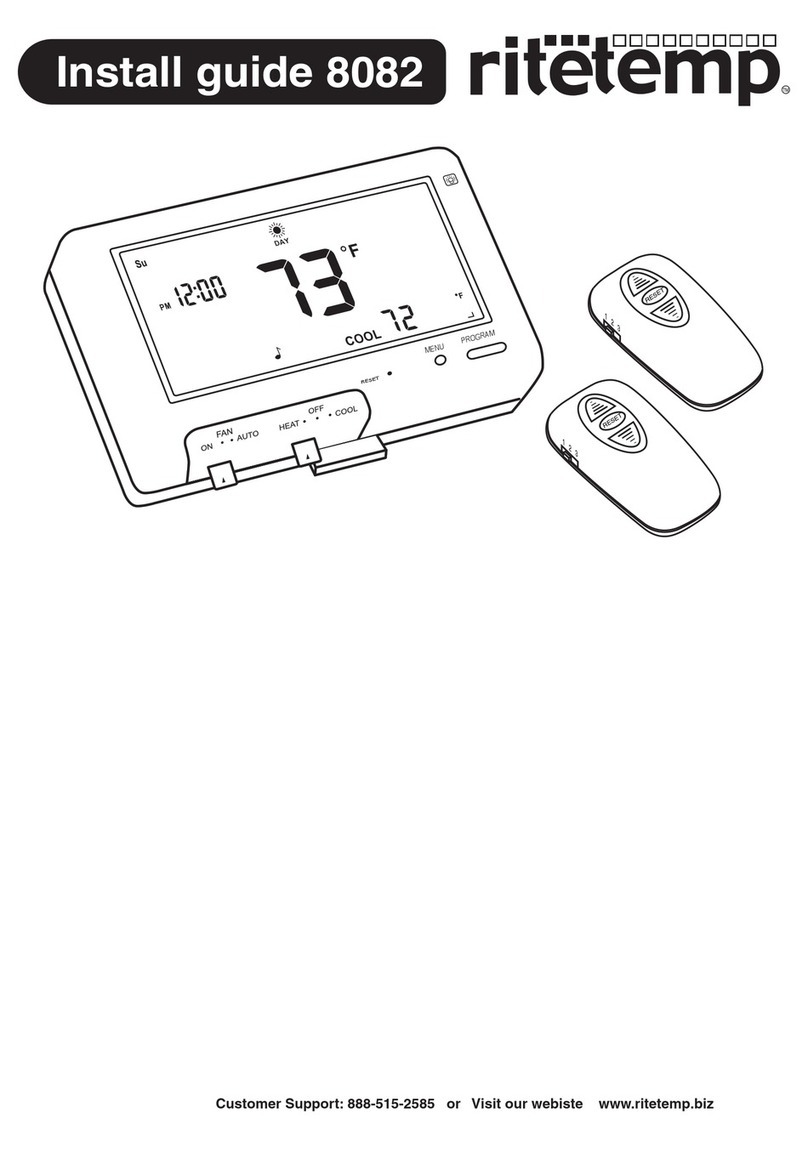Vimar 02972 User guide

Installer manual
BUILDING AUTOMATION
02972
KNX Wheel-Thermostat

Index

Index
GENERAL CHARACTERISTICS AND FUNCTIONS from page 5
COMMUNICATION OBJECTS AND ETS PARAMETERS from page 7
FAQ from page 28
COMMUNICATION OBJECTS GENERAL CHARACTERISTICS AND FUNCTIONS
FAQ

4
For all the details about the Well-contact Plus system, refer to the installer manual that can be downloaded from
the Software Product Software Well-contact Plus section of the website: www.vimar.com.

5
General characteristics and functions
GENERAL CHARACTERISTICS AND FUNCTIONS
Thermostat
Electronic dial thermostat for room temperature control
(heating and air conditioning), KNX standard home automa-
tion system, class I temperature control device (contribution
1%) in ON/OFF mode, class IV (contribution 2%) in PID
mode, can be interfaced with actuator with KNX propor-
tional analogue outputs to implement a class V modulating
room thermostat (contribution 3%), 1 input for electronic
temperature sensor 20432, 19432 or 14432 or wired tempe-
rature sensor 02965.1, 1 programmable digital input, white/
grey LED backlighting - 2 modules. To be completed with
Eikon, Arké, Plana cover plates. For Idea, can be installed
using the dedicated mounting frame 16723.
General characteristics
Il termo The thermostat is fitted with a front dial to adjust the
setpoint (between 4°C and 40°C) and a central white LED
backlit display to show the measured temperature, and show the
setpoint only when the dial is being used. The circular ring around
the display, with RGB backlighting, displays all the thermostat
statuses. The device is fitted with 4 front buttons to be used for
setting. The thermostat, physical address, parameters and its
operation, etc. are configured via the ETS software.
Front view
Circular ring
Default behaviour
Thermostat OFF Protection mode
Thermostat ON Comfort mode
Behaviour after bus power on/off
Bus power off: -.
Bus power on: the status will be set based on the setting of the
parameters and the corresponding telegrams sent over the Bus.
Behaviour after reset
As for Bus power-on.
N.B. The thermostat saves the comfort and standby setpoints
set manually by the user; if you wish to reset them, set the ETS
parameter "Reset Setpoint Shift in Economy Mode=YES".
When switched to "Economy" mode, the thermostat will reset
the STBY and CNF values.
A
D
F
B
E
G
C
1
A• Short press = degrees Celsius/Fahrenheit selection
B
Configurable functions:
- send scene (only one scene)
- light ON/OFF button
- show external temperature from connected temperature sensor
- choice season (Heating/Cooling)
C
Display
• off = thermostat off; on = thermostat on
• °C = degrees Celsius; °F = degrees Fahrenheit
• H = heating; C = air conditioning
D
Dial
• Rotation = set point increase (0.1 °C - 0.2 °F)
• Rotation = set point decrease (0.1 °C - 0.2 °F)
EIlluminating circular ring
F
• Power on and off.
At power on or off, the thermostat starts in the last operating mode associated with it
G• Short press = fan coil speed adjustment (0-1-2-3 or Proportional/Automatic)
All lit amber* = thermostat in heating mode and relay active
All lit blue** = thermostat in air conditioning mode and relay active
All flashing red = thermostat locked, alarm state
1
• Lit amber* = thermostat in heating mode and relay not active
• Lit blue** = thermostat air conditioning mode and relay not active
* Amber with automatic colour; of the selected colour if monochrome.
** Blue with automatic colour; of the selected colour if monochrome.

6
General characteristics and functions
Thermostat
Neutral zone
The "Neutral Zone" is an operating mode of the thermostat (only
for 4-pipe systems) in which the device keeps the temperature
within a temperature range preset by the Winter Setpoint
and Summer Setpoint (basically, there is no longer the usual
Summer/Winter mode).
If the measured temperature is below the Winter Setpoint, the
thermostat switches on the heating valve and heats the room until
the temperature exceeds the set value (e.g. 20°C for Comfort
mode or 18°C for Standby mode). If the measured temperature
exceeds the Summer Setpoint then the thermostat switches
on the cooling valve and keeps it on until the temperature falls
below the set Summer Setpoint value.
Within the Neutral Zone the thermostat does not switch on any
valves and the temperature can vary freely; this zone is therefore
nothing more than the difference between the Summer and
Winter Setpoints when the room temperature is between the
winter setpoint and the summer one.
To avoid excessive temperature fluctuations, set a limited range
(≤ 2°C) as shown in the figure below.
Winter Setpoint
Summer Setpoint
COOLING
HEATING
NEUTRAL ZONE
Setpoint displayed in Neutral Zone operation
When the thermostat is working in the neutral zone, the setpoint
used for the adjustment is always the Current Setpoint, namely
the one relating to the last heating/cooling mode that came into
operation; the value displayed is instead a new setpoint named
"Neutral Zone Setpoint”, which is the average value between
the current summer and winter setpoints.
Changing the temperature of the "Neutral Zone Setpoint” (with
the "+” and "-” buttons on the thermostat) will also cause a
change to the value of the "Shift Setpoint” resulting in a shift
of the two current summer/winter setpoint values; the room
temperature will therefore not become the one set by the guest
but that of the summer/winter setpoint which at that moment
is closest to the value of the current temperature in the room.
Between the two summer/winter setpoints, there is the neutral
zone in which the system is not activated.
Mid Season
This function is available from the supervisor only for systems
configured with primary and secondary output; when active,
it exchanges the 2 main and secondary outputs (and the
related parameters too). It is recommended for making minor
adjustments (such as +/-2 °C) during mid season periods where
it may be more convenient to operate only the secondary circuit
(for instance Split).
Configuration
The KNX 02972 thermostat is configured in Neutral Zone mode
if the following object is NOT connected: "Enable A: Summer -
Winter – control" or "Enable B: Summer - Winter – control".
The thermostat can operate in Neutral Zone IF:
• The system has 4 pipes
• Winter Comfort Setpoint < Summer Comfort Setpoint
• Winter Standby Setpoint < Summer Standby Setpoint
• Winter Economy Setpoint < Summer Economy Setpoint
• Antifreeze < Too Hot
If these conditions are not satisfied, you can still commission
the thermostat; if there is an error while starting up, the device
will remain in "Protected” mode and an error message will be
displayed.
Types of errors at the time of configuration
Error No. Description
E1 Selected 2-pipe system instead of 4-pipe
system
E2 Winter Comfort Setpoint ≥ Summer Comfort
Setpoint
E3 Winter Standby Setpoint ≥ Summer Standby
Setpoint
E4 Winter Economy Setpoint ≥ Summer Economy
Setpoint
E5 Antifreeze ≥ Too Hot
N.B. Errors E2, E3, E4 and E5 may also be displayed if the
thermostat is programmed in "4-pipe system" mode without
the neutral zone according to the type of Setpoint shown in the
table.

7
Thermostat
No. ETS name Function Description Type Flag 1 Priority
C R W T U I
1 Internal sensor Internal probe temperature
To see the temperature read by the thermostat sensor
(to see the temperatures measured by thermostats A/B
with Well-Contact Suite software, objects nos. 10/11
should be used)
2 byte C R - T - - Low
2 External sensor External NTC probe temper-
ature
To see the temperature read by the wired NTC probe
connected to the thermostat (to see the temperatures
measured by thermostats A/B with Well-Contact Suite
software, objects nos. 10/11 should be used)
2 byte C R - T - - Low
3 External Temperature 1 KNX probe temperature on bus
To see the temperature read by a KNX sensor con-
nected to the bus (to see the temperatures measured
by thermostats A/B with Well-Contact Suite software,
objects nos. 10/11 should be used)
2 byte C - W - U - Low
4 External Temperature 2 KNX probe temperature on bus
To see the temperature read by a KNX sensor con-
nected to the bus (to see the temperatures measured
by thermostats A/B with Well-Contact Suite software,
objects nos. 10/11 should be used)
2 byte C - W - U - Low
5 External Temperature 3 KNX probe temperature on bus
To see the temperature read by a KNX sensor con-
nected to the bus (to see the temperatures measured
by thermostats A/B with Well-Contact Suite software,
objects nos. 10/11 should be used)
2 byte C - W - U - Low
6 External Temperature 4 KNX probe temperature on bus
To see the temperature read by a KNX sensor con-
nected to the bus (to see the temperatures measured
by thermostats A/B with Well-Contact Suite software,
objects nos. 10/11 should be used)
2 byte C - W - U - Low
7 External Temperature 5 KNX probe temperature on bus
To see the temperature read by a KNX sensor con-
nected to the bus (to see the temperatures measured
by thermostats A/B with Well-Contact Suite software,
objects nos. 10/11 should be used)
2 byte C - W - U - Low
8 External Temperature 6 KNX probe temperature on bus
To see the temperature read by a KNX sensor con-
nected to the bus (to see the temperatures measured
by thermostats A/B with Well-Contact Suite software,
objects nos. 10/11 should be used)
2 byte C - W - U - Low
9 External Temperature 7 KNX probe temperature on bus
To see the temperature read by a KNX sensor con-
nected to the bus (to see the temperatures measured
by thermostats A/B with Well-Contact Suite software,
objects nos. 10/11 should be used)
2 byte C - W - U - Low
10 External Temperature 8 KNX probe temperature on bus
To see the temperature read by a KNX sensor con-
nected to the bus (to see the temperatures measured
by thermostats A/B with Well-Contact Suite software,
objects nos. 10/11 should be used)
2 byte C - W - U - Low
11 Current Temperature A: Temperature
To see the current temperature associated with ther-
mostat-A (weighted average of the various associated
probes): this object is used with Well-Contact Suite
software to see the temperature measured by thermo-
stat A
2 byte C R - T - - Low
12 Current Temperature B: Temperature
To see the current temperature associated with ther-
mostat-B (weighted average of the various associated
probes): this object is used with Well-Contact Suite
software to see the temperature measured by thermo-
stat B
2 byte C R - T - - Low
THERMOSTAT A:
13 Comfort A: Mode - control To select COMFORT operating mode by sending a 1 bit
or to set the thermostat to STANDBY by sending a 0 bit 1 bit C - W - U - Low
14 Energy Saving A: Mode - control To select ECONOMY operating mode by sending a 1
bit (a 0 bit is ignored) 1 bit C - W - U - Low
15 Protected A: Mode - control To select OFF-ANTIFREEZE operating mode (or Too
Hot in the case of air conditioning) by sending a 1 bit. 1 bit C - W - U - Low
16 Off A: Mode - control To select OFF operating mode by sending a 1 bit (a 0
bit is ignored) 1 bit C R W - U - Low
17 Thermostat Mode A: Mode - control
To select operating mode by sending a Byte (1 =
Comfort, 2 = StandBy, 3 = Economy, 4 = Protection). If
you use supervision with Well Contact Suite this object
must be associated with a group.
1 byte C - W - U - Low
18 Thermostat Mode A: Mode - status
To read the set operating mode by sending a Byte (1 =
Comfort, 2 = StandBy, 3 = Economy, 4 = Protection). If
you use supervision with Well Contact Suite this object
must be associated with a group.
1 byte C R - T - - Low
List of existing communication objects and standard settings
Continued C= Communication; R= Read; W= Write; T= Transmission; U= Enable update
Communication objects and ETS parameters
COMMUNICATION OBJECTS

8
Thermostat
No. ETS name Function Description Type Flag 1 Priority
C R W T U I
19 Status A: Mid season - status To read the seasonal mode set on the thermostat (0 =
MS Not Active, 1 = MS Active) 1 bit C R - T - - Low
20 Enable A: Mid season - control To select the seasonal mode set on the thermostat (0 =
MS Not active, 1 = MS Active) 1 bit C - W - U - Low
21 Status A: Summer - Winter - status To read the seasonal mode set on the thermostat (0 =
Summer, 1 = Winter) 1 bit C R - T - - Low
22 Enable A: Summer - Winter - control
To set the seasonal mode on the thermostat
(1 = Winter, 0 = Summer). If it is NOT associated with
a group then thermostat A will function in Neutral Zone
mode.
1 bit C - W - U - Low
23 Thermostat Off A: OFF communication - bus
- control
This function is useful in the event of faults on the heat-
ing system to disable the valves with a 1 bit. 1 bit C - W - U - Low
24 Dewpoint A: Thermostat - control
If a 1 bit is sent to this object, the thermostat turn OFF
and stop the air conditioner (this works only in air condi-
tioning mode and serves for example to avoid conden-
sation on the floor) - Note: The thermostat requires a
cyclical send to this object, with a time that can be set
in the parameter "Dewpoint Supervision Time"
1 bit C - W - U - Low
25 NOT USED
26 Current Setpoint A: Setpoint - status
To read the temperature setpoint set on the thermostat.
If you want Well-contact Suite to know the setpoint cur-
rently set on the thermostats, this object must be linked
to a group
2 byte C R - T - - Low
27 Setpoint Shift A: Setpoint - status, control
To read and control a temperature shift with respect to
the current setpoint (setpoint set by ETS on the thermo-
stat for the various operating modes CMF, STBY, etc.).
The temperature shift permitted is limited to the range
set by the parameter: Guest Control Permitted.
If parameter Guest Control Permitted is set to Off the
“Setpoint Shift” object does not shift the active setpoint.
2 byte C R W T - - Low
28 Winter Comfort A: Setpoint - status, control To read and set the Winter Comfort setpoint. 2 byte C R W T U - Low
29 Winter Standby A: Setpoint - status, control To read and set the Winter Standby setpoint 2 byte C R W T U - Low
30 Winter Energy Saving A: Setpoint - status, control To read and set the Winter Economy setpoint 2 byte C R W T U - Low
31 Winter Protected A: Setpoint - status, control To read and set the Winter Antifreeze setpoint 2 byte C R W T U - Low
32 Summer Comfort A: Setpoint - status, control To read and set the Summer Comfort setpoint 2 byte C R W T U - Low
33 Summer Standby A: Setpoint - status, control To read and set the Summer Standby setpoint 2 byte C R W T U - Low
34 Summer Energy Saving A: Setpoint - status, control To read and set the Summer Economy setpoint 2 byte C R W T U - Low
35 Summer Protected A: Setpoint - status, control To read and set the Summer Too Hot setpoint (power-off
of climate control if the window is opened, for instance) 2 byte C R W T U - Low
36 NOT USED
37 NOT USED
38 NOT USED
Thermostat A: Valves
39 Cooling Valve A: Valve
If the "Valve" parameter is set for 4-pipe systems for
valve management in Summer: to be used to control
the head of a radiating system or the On/Off valve of a
fan coil
1 bit C R - T - - Low
40 Heating Valve A: Valve
If the "Valve" parameter is set for 4-pipe systems for
valve management in Winter: to be used to control the
head of a radiating system or the On/Off valve of a fan
coil
1 bit C R - T - - Low
41 Cooling Valve A: 2-nd stage cooling If second cooling stage is enabled to be used for the
boost function (cooling) for on/off valve control 1 bit C R - T - - Low
42 Heating Valve A: 2-nd stage heating If second heating stage is enabled to be used for the
boost function (heating) for proportional valve control 1 byte C R - T - - Low
Continued
C= Communication; R= Read; W= Write; T= Transmission; U= Enable update
Communication objects and ETS parameters
Continued

9
No. ETS name Function Description Type Flag 1 Priority
C R W T U I
Thermostat A: Fan
43 Proportional
(0-100%) A: Fan Inputs
Used to set a proportional speed for the fan coil fan (if
the selected fan is proportional with 3 speeds) via a su-
pervisor (e.g., touch screen)
1 byte C - W - U - Low
44 NOT USED
45 V1 speed A: Fan Inputs Used to force activation of fan coil speed V1 (if the
selected fan has 3 speeds) 1 bit C - W - U - Low
46 V2 speed A: Fan Inputs Used to force activation of fan coil speed V2 (if the
selected fan has 3 speeds) 1 bit C - W - U - Low
47 V3 speed A: Fan Inputs Used to force activation of fan coil speed V3 (if the
selected fan has 3 speeds) 1 bit C - W - U - Low
48 Automatic A: Fan Inputs Used to force activation of fan coil speed AUTO (if the
selected fan has 3 speeds) 1 bit C - W - U - Low
49 NOT USED
50 Off A: Fan Outputs
Used to read the deactivation status of all 3 speeds (if
the selected fan has 3 speeds). The thermostat sends a
1 bit when the fan is off (fan coil speed 0).
1 bit C R - T - - Low
51 V1 speed A: Fan Outputs
This is the object to pair with the relay of speed 1 of the
fan coil (to read the status of speed V1 of the fan coil,
this object can be polled by the bus)
1 bit C R - T - - Low
52 V2 speed A: Fan Outputs
This is the object to pair with the relay of speed 2 of the
fan coil (to read the status of speed V2 of the fan coil,
this object can be polled by the bus)
1 bit C R - T - - Low
53 V3 speed A: Fan Outputs
This is the object to pair with the relay of speed 3 of the
fan coil (to read the status of speed V3 of the fan coil,
this object can be polled by the bus)
1 bit C R - T - - Low
54 V1 speed A: Fan Disable To disable speed V1 (if the selected fan has 3 speeds) 1 bit C R W T U - Low
55 V2 speed A: Fan Disable To disable speed V2 (if the selected fan has 3 speeds) 1 bit C R W T U - Low
56 V3 speed A: Fan Disable To disable speed V3 (if the selected fan has 3 speeds) 1 bit C R W T U - Low
Thermostat A: Window
57 Window Sensor A: Window
Object to be paired with the input to which a win-
dow-contact is connected so that the thermostat
switches to OFF-PROTECTED when the window is
opened, depending on whether the mode is Air Condi-
tioning or Heating
1 bit C - W - U - Low
Thermostat A: Scenario
58 Scenario A: Scenario To activate a scenario with a 1 Byte message 1 byte C - W - U - Low
Thermostat A: Auto/Man
59 Temperature:
Automatic/Manual A: Manual operation To see whether the guest has altered the thermostat
temperature setpoint with respect to the default setting 1 bit C R - T - - Low
60 Fan coil:
Automatic/Manual A: Manual operation To see whether the guest has altered the fan coil speed
with respect to the default setting 1 bit C R - T - - Low
61 Temperature: Disable
Local operation A: Manual operation
Activating this object prevents the guest from altering
the setpoint temperature by means of the thermostat
buttons with respect to the value set by the bus
1 bit C - W - U - Low
62 Fan coil: Disable Local
Operation A: Manual operation
Activating this object prevents the guest from altering
the fan coil speed by means of the thermostat buttons
with respect to the value set by the bus
1 bit C - W - U - Low
Thermostat
C= Communication; R= Read; W= Write; T= Transmission; U= Enable update
Continued
Communication objects and ETS parameters
COMMUNICATION OBJECTS
Continued

10
Thermostat
Continued
C= Communication; R= Read; W= Write; T= Transmission; U= Enable update
No. ETS name Function Description Type Flag 1 Priority
C R W T U I
Thermostat A: Floor Probe Alarm
63 Temperature
Floor A: Alarm If the temperature limitation is active an alarm is sent
when the temperature exceeds the set threshold 1 bit C R - T - - Low
THERMOSTAT B:
64 Comfort B: Mode - control To select COMFORT operating mode by sending a 1 bit
or to set the thermostat to STANDBY by sending a 0 bit 1 bit C - W - U - Low
65 Energy Saving B: Mode - control To select ECONOMY operating mode by sending a 1
bit (a 0 bit is ignored) 1 bit C - W - U - Low
66 Protected B: Mode - control To select ANTIFREEZE operating mode (or Too Hot in
the case of air conditioning) by sending a 1 bit. 1 bit C - W - U - Low
67 Off B: Mode - control To select OFF operating mode by sending a 1 bit (a 0
bit is ignored) 1 bit C R W - U - Low
68 Thermostat Mode B: Mode - control
To select operating mode by sending a Byte (1 =
Comfort, 2 = StandBy, 3 = Economy, 4 = Protection). If
you use supervision with Well Contact Suite this object
must be associated with a group.
1 byte C - W - U - Low
69 Thermostat Mode B: Mode - status
To read the set operating mode by sending a Byte (1 =
Comfort, 2 = StandBy, 3 = Economy, 4 = Protection). If
you use supervision with Well Contact Suite this object
must be associated with a group.
1 byte C R - T - - Low
70 Status B: Mid season - status To read the seasonal mode set on the thermostat (0 =
MS Not Active, 1 = MS Active)
71 Enable B: Mid season - control To select the seasonal mode set on the thermostat (0 =
MS Not active, 1 = MS Active)
72 Status B: Summer - Winter - status To read the seasonal mode set on the thermostat (0 =
Summer, 1 = Winter) 1 bit C R - T - - Low
73 Enable B: Summer - Winter - control
To set the seasonal mode on the thermostat
(1 = Winter, 0 = Summer). If it is NOT associated with
a group then thermostat B will function in Neutral Zone
mode.
1 bit C - W - U - Low
74 Thermostat Off B: OFF communication - bus
- control
This function is useful in the event of faults on the heat-
ing system to disable the valves with a 1 bit. 1 bit C - W - U - Low
75 Dewpoint B: Thermostat - control
If a 1 bit is sent to this object, the thermostat turn OFF
and stop the air conditioner (this works only in air condi-
tioning mode and serves for example to avoid conden-
sation on the floor) - Note: The thermostat requires a
cyclical send to this object, with a time that can be set
in the parameter "Dewpoint Supervision Time"
1 bit C - W - U - Low
76 NOT USED
77 Current Setpoint B: Setpoint - status
To read the temperature setpoint set on the thermostat.
If you want Well-contact Suite to know the setpoint cur-
rently set on the thermostats, this object must be linked
to a group
2 byte C R - T - - Low
78 Setpoint Shift B: Setpoint - status, control
To read and control a temperature shift with respect to
the current setpoint (setpoint set by ETS on the thermo-
stat for the various operating modes CMF, STBY, etc.).
The temperature shift permitted is limited to the range
set by the parameter: Guest Control Permitted. If param-
eter Guest Control Permitted is set to Off the “Setpoint
Shift” object does not shift the active setpoint.
2 byte C R W T - - Low
79 Winter Comfort B: Setpoint - status, control To read and set the Winter Comfort setpoint. 2 byte C R W T U - Low
80 Winter Standby B: Setpoint - status, control To read and set the Winter Standby setpoint 2 byte C R W T U - Low
81 Winter Energy Saving B: Setpoint - status, control To read and set the Winter Economy setpoint 2 byte C R W T U - Low
82 Winter Protected B: Setpoint - status, control To read and set the Winter Antifreeze setpoint 2 byte C R W T U - Low
83 Summer Comfort B: Setpoint - status, control To read and set the Summer Comfort setpoint 2 byte C R W T U - Low
84 Summer Standby B: Setpoint - status, control To read and set the Summer Standby setpoint 2 byte C R W T U - Low
85 Summer Energy Saving B: Setpoint - status, control To read and set the Summer Economy setpoint 2 byte C R W T U - Low
Communication objects and ETS parameters
Continued

11
No. ETS name Function Description Type Flag 1 Priority
C R W T U I
86 Summer Protected B: Setpoint - status, control To read and set the Summer Too Hot setpoint (power-off
of climate control if the window is opened, for instance) 2 byte C R W T U - Low
87 NOT USED
Thermostat B: Valves
90 Cooling Valve B: Valve
If the "Valve" parameter is set for 4-pipe systems for
valve management in Summer: to be used to control
the head of a radiating system or the On/Off valve of a
fan coil
1 bit C R - T - - Low
91 Heating Valve B: Valve
If the "Valve" parameter is set for 4-pipe systems for
valve management in Winter: to be used to control the
head of a radiating system or the On/Off valve of a fan
coil
1 bit C R - T - - Low
92 Cooling Valve B: 2-nd stage cooling If second cooling stage is enabled to be used for the
boost function (cooling) for on/off valve control 1 bit C R - T - - Low
93 Heating Valve B: 2-nd stage heating If second heating stage is enabled to be used for the
boost function (heating) for proportional valve control 1 byte C R - T - - Low
Thermostat B: Fan
94 Proportional
(0-100%) B: Fan Inputs
Used to set a proportional speed for the fan coil fan (if
the selected fan is proportional or 8-bit with 3 speeds)
via a supervisor (e.g., touch screen)
1 byte C - W - U - Low
95 NOT USED
96 V1 speed B: Fan Inputs Used to force activation of fan coil speed V1 (if the
selected fan has 3 speeds) 1 bit C - W - U - Low
97 V2 speed B: Fan Inputs Used to force activation of fan coil speed V2 (if the
selected fan has 3 speeds) 1 bit C - W - U - Low
98 V3 speed B: Fan Inputs Used to force activation of fan coil speed V3 (if the
selected fan has 3 speeds) 1 bit C - W - U - Low
99 Automatic B: Fan Inputs Used to force activation of fan coil speed AUTO (if the
selected fan has 3 speeds) 1 bit C - W - U - Low
100 Proportional
(0-100%) B: Fan Outputs
Used to read the proportional speed of the fan coil fan (if
the selected fan is proportional or 8-bit with 3 speeds).
This object is used for controlling proportional actuators.
1 byte C R - T - - Low
101 Off B: Fan Outputs
Used to read the deactivation status of all 3 speeds (if
the selected fan has 3 speeds). The thermostat sends a
1 bit when the fan is off (fan coil speed 0).
1 bit C R - T - - Low
102 V1 speed B: Fan Outputs
This is the object to pair with the relay of speed 1 of the
fan coil (to read the status of speed V1 of the fan coil,
this object can be polled by the bus)
1 bit C R - T - - Low
103 V2 speed B: Fan Outputs
This is the object to pair with the relay of speed 2 of the
fan coil (to read the status of speed V2 of the fan coil,
this object can be polled by the bus)
1 bit C R - T - - Low
104 V3 speed B: Fan Outputs
This is the object to pair with the relay of speed 3 of the
fan coil (to read the status of speed V3 of the fan coil,
this object can be polled by the bus)
1 bit C R - T - - Low
105 V1 speed B: Fan Disable To disable speed V1 (if the selected fan has 3 speeds) 1 bit C R W T U - Low
106 V2 speed B: Fan Disable To disable speed V2 (if the selected fan has 3 speeds) 1 bit C R W T U - Low
107 V3 speed B: Fan Disable To disable speed V3 (if the selected fan has 3 speeds) 1 bit C R W T U - Low
Thermostat B: window
108 Window Sensor B: Window
Object to be paired with the input to which a win-
dow-contact is connected so that the thermostat
switches to OFF-PROTECTED when the window is
opened, depending on whether the mode is Air Condi-
tioning or Heating
1 bit C - W - U - Low
Continued
Thermostat
Communication objects and ETS parameters
C= Communication; R= Read; W= Write; T= Transmission; U= Enable update
COMMUNICATION OBJECTS
Continued

12
Thermostat
Communication objects and ETS parameters
No. ETS name Function Description Type Flag 1 Priority
C R W T U I
Thermostat B: scenario
109 Scenario B: Scenario To activate a scenario with a 1 Byte message 1 byte C - W - U - Low
Thermostat B: Auto/Man
110 Temperature:
Automatic/Manual B: Manual operation To see whether the guest has altered the thermostat
temperature setpoint with respect to the default setting 1 bit C R - T - - Low
111 Fan coil:
Automatic/Manual B: Manual operation To see whether the guest has altered the fan coil speed
with respect to the default setting 1 bit C R - T - - Low
112 Temperature: Disable
Local operation B: Manual operation
Activating this object prevents the guest from altering
the setpoint temperature by means of the thermostat
buttons with respect to the value set by the bus
1 bit C - W - U - Low
113 Fan coil: Disable
Local Operation B: Manual operation
Activating this object prevents the guest from altering
the fan coil speed by means of the thermostat buttons
with respect to the value set by the bus
1 bit C - W - U - Low
Thermostat B: Floor Probe Alarm
114 Temperature
Floor B: Alarm If the temperature limitation is active an alarm is sent
when the temperature exceeds the set threshold 1 bit C R - T - - Low
GLOBAL
115 NOT USED
116 NOT USED
117 NOT USED
119 Input Input To control the IN input of the thermostat 1 bit C R - T - - Low
121
Send scene
Button
Only one scenario can be enabled
1 byte C R - T - - Low
Light ON/OFF Light button function (ON/OFF)
Show external
temperature
Enable/disable display of temperature from connected
temperature sensor.
Heating/Air condition-
ing mode selection
To select between Winter (Heating) = orange color
or Summer (Cooling) = azure color
Continued
C= Communication; R= Read; W= Write; T= Transmission; U= Enable update
Number of communication objects Max. number of group addresses Max. number of associations
107 254 255

13
Reference ETS parameters
General parameters
General
ETS text Values available Comment
[Default value]
Value shown on the display
0 = Show Room tem-
perature
You can choose
whether to view on
the display: the tem-
perature measured,
the fan coil speed
and the valve status,
no information, the
temperature delta
compared to the
Setpoint set by the
project
1 = Current setpoint
2 = Display Off
3 = View Setpoint Dif-
ference
[0]
Button Activation
0 = Enable You can choose
whether to make the
thermostat buttons
operative
1 = Disable
[0]
Temperature Unit of meas-
ure
0 = Celsius
Only for the display
1 = Fahrenheit
[0]
Mid Season Management
0 = Enable
To invert primary and
secondary
1 = Disable
[0]
Stand-by brightness
0 = Off
Defines the bright-
ness of the display
when the thermostat
goes on standby
1 = Low
2 = Medium
3 = High
[0]
Monochrome mode to blend in the colours of the thermostat with those
of the wiring series: Default colours (for instance Red, Amber, etc.)
Thermostat
Communication objects and ETS parameters
Monochrome mode to blend in the colours of the thermostat with those
of the wiring series: Customised colour (RGB setting)
N.B. By activating mid season:
- the valve is deactivated and is never activated;
- the speed settings are activated/deactivated based on a setpoint
to reach;
- the 2nd stage of Cooling/Heating is activated based on the setpoint
to be reached.
COMMUNICATION OBJECTS

14
Thermostat
Communication objects and ETS parameters
Digital Input
ETS text Values available Comment
[Default value]
Input Function
0 = General Use If set as "General use", it
also sends 0/1 over the bus
towards a supervisor
1 = Window Sensor
[0]
Function (for gener-
al use)
0 = Switching on Rising
Edge Rising edge = close contact
1 = Toggle on Rising
Edge Falling edge = open contact
2 = Switching on Falling
Edge
Switching = sends a 1 bit
value (On/Off) on opening
and the opposite on closing
3 = Toggle on Falling
Edge
Toggle = on every defined
edge (opening or closure),
On and then Off is sent to
the cycle
4 = Status Send
To send the contact status
upon each switching and
also cyclically.
[0]
Window Sensor
Mode (for thermo-
stat-A and thermo-
stat-B)
0 = Deactivated Defines whether the window
sensor is normally open or
closed.
1 = Normally Open
2 = Normally Closed
[0]
Digital Input Parameters
Digital Input - Window Sensor
Digital Input - General Use
Internal/External Temperature Sensor (Thermostat-A,
Thermostat-B)
ETS text Values available Comment
[Default value]
Temperature Offset
-2 °C ... .+2 °C Calibration of thermo-
stat reading
(or of average of
probes)
[0]
Cyclic Send Time
0...30 min.
0=Off.
Activates cyclic send
of object no. 0 "In-
ternal Sensor" or
no. 1 "External Sen-
sor" (both for the
thermostat A and
for thermostat B)
[0 = Off]
Send on Change
0... 1.0 °C Sets the minimum
measured tem-
perature change
with respect to the
setpoint that will
cause the thermostat
to send the current
value over the bus to
a supervisor.
[0 = Off]
Internal/external temperature sensor
Sensor parameters
Note: If you use the Well Contact Suite supervision system to
update the value displayed by the supervision station of the “A/B
Current Temperature" linked to objects nos. 10 and 11, you
must enable cyclic send or send on change. In the event of a
conjunction of a high number of thermostats, it is not advisable
to enable numerous cyclic sends with timing that is too low to
avoid overloading the BUS communications.

15
Thermostat
Communication objects and ETS parameters
Thermostat (A/B)
ETS text Values available Comment
[Default value]
Guest control per-
mitted
0 = Off
Determine how much the
guest can change the set-
point from the value set on
the thermostat (up/down)
1 = 1.0 °C
2 = 2.0 °C
3 = 3.0 °C
4 = 4.0 °C
5 = 5.0 °C
6 = None Limitation
[3]
Setpoint shift step
0.1, 0.2....1 For thermostat A setpoint
shift step upon receipt of
control on objects 115 and
116
[1]
Thermostat (A/B)
Guest control permitted
Current Temperature (A/B)
ETS text Values available Comment
[Default value]
Temperature sen-
sor weightings
0... 100
For the thermostat's internal
sensor, the Vimar wired NTC
probe (if present) and the
KNX probes, this determines
the relative importance for
calculating the weighted av-
erage of the measured tem-
peratures
[0]
Cyclic Send Time
0 = Off Sets the frequency in minutes
with which the thermostat (A/B)
must send the measured tem-
perature value (or the weighted
average of the probes) over the
bus to a supervisor. Activates
cyclic send of object no. 10 and
11 "Current Temperature" of
thermostat A/B
11 = 30 min.
[0 = Off]
Send on Change
0 = Off Sets the temperature difference
measured by the thermostat
(A/B) that results in the read val-
ue (or the weighted average of
the probes) being sent over the
bus towards a supervisor. Acti-
vates cyclic send of object no.
10 and 11 "Current Tempera-
ture" of thermostat A/B
1.0 = 1.0 °C
[0 = Off]
Current temperature (A/B)
COMMUNICATION OBJECTS

16
Setpoint (A/B)
ETS text Values available Comment
[Default value]
Mode at bus power
on
1 = Comfort
Thermostat operating mode
at bus power on
2 = Standby
3 = Energy saving
4 = Protect
255 = Last Mode
Selected
[255]
Time between
Heating and
Cooling
1 min.
To avoid the formation of
condensation with radiating
systems during changes of
season
10 min.
15 min.
20 min.
25 min.
30 min.
45 min.
60 min.
[30]
Dewpoint
Supervision Time
0 = Off
Sets the time within which
the thermostat must
receive a message to the
"Dewpoint" object from
a device connected to a
humidistat.
A bit set to "1" will stop
heating/air conditioning and
set to "0" will cause it to
restart. If messages have
not arrived, when this time
has elapsed heating/air con-
ditioning will restart
30 sec
1 min.
2 min.
3 min.
4 min.
5 min.
10 min.
15 min.
20 min.
25 min.
30 min.
[0 = Off]
Cyclic Send Time
0 = Off
Sets the time for cyclic
sending of temperature
setpoint over bus towards a
supervisor
30 sec.
1 min.
2 min.
3 min.
4 min.
5 min.
10 min.
15 min.
20 min.
25 min.
30 min.
[0 = Off]
Send on Change
0 = Off
Sets the minimum temper-
ature change made by the
guest with respect to the
setpoint that results in the
current setpoint being sent
over the bus towards a
supervisor
0.1 °C
0.2 °C
0.3 °C
0.4 °C
0.5 °C
0.6 °C
0.7 °C
0.8 °C
0.9 °C
1.0 °C
[0 = Off]
Reset Setpoint
Shift in Economy
Mode
Yes By selecting “Yes”, when the
thermostat goes into Energy
Saving (Economy) mode,
the setpoint set by the user
in Comfort and Standby
mode is reset to the design
default value. This function
is useful for hotel appli-
cations and with the Well
Contact Suite supervision
software.
No
[Yes]
Setpoint parameters
Setpoint parameters
Thermostat
Communication objects and ETS parameters
Important: The "Time between Heating and Cooling” param-
eter is the wait time it takes for the thermostat to switch from
summer-winter and vice versa. This parameter is especially
useful in some underfloor radiant systems where you set a high
time value to prevent the formation of condensation; this applies
especially when the thermostats work with a neutral zone and
so there could be multiple seasonal changes in a single day.
If instead, depending on the type of system, you want a faster
response of the thermostat, it is necessary to reduce the value
of this parameter.

17
Thermostat
Communication objects and ETS parameters
Continued
Continued
Temperature Setpoint (A/B)
ETS text Values available Comment
[Default value]
Winter Comfort Setpoint [20] See "Range" table
Winter Standby Setpoint [18] See "Range" table
Winter Energy
Saving Setpoint [15] See "Range" table
Antifreeze
0 = Control Off
If you set "On"
you can set the
temperature the
thermostat goes to in
"Protected" mode; if
you set "Off", when
the thermostat is in
"Protected" mode it
will turn off tempera-
ture control and will
not send the current
setpoint temperature
1 = Control On
[1 = 011]
Summer Comfort
Setpoint [25] See "Range" table
Summer Standby
Setpoint [28] See "Range" table
Summer Energy
Saving Setpoint [30] See "Range" table
ETS text Values available Comment
[Default value]
Too hot
0 = Control Off
If you set "On"
you can set the
temperature the
thermostat goes to in
"Protected" mode; if
you set "Off", when
the thermostat is in
"Protected" mode it
will turn off tempera-
ture control and will
not send the current
setpoint temperature
1 = Control On
[1 = On]
Sensor parameters
Temp. °C
5
6
7
8
9
10
11
12
13
14
15
Temp. °C
16
17
18
19
20
21
22
23
24
25
26
Temp. °C
27
28
29
30
31
32
33
34
35
36
37
Temp. °C
38
39
40
41
42
43
44
45
Setpoint range
Note: In the case of a 4-pipe system, the winter setpoint cannot
take a higher value than the summer setpoint.
CAUTION: When the thermostat is in Neutral Zone mode,
the breadth of this must be progressively increasing for
the different operating modes of Comfort (minimum neutral
zone breadth), Standby, Energy Saving and Protected. This
setting made with ETS ensures that, when the thermostat
changes operating mode, the active setpoint is always at
a suitable value and the thermostat does not start cooling
if it was heating before or vice versa, causing considerable
energy consumption.
Temperature setpoint parameters
COMMUNICATION OBJECTS

18
Window sensor (A/B)
ETS text Values available Comment
[Default value]
Window sensor
delay
0 = Off Sets the time delay that
heating/air conditioning
stops after window open
detection
8 = 120 sec.
[4 = 30]
Window sensor (A/B)
Sensor parameters
Thermostat
Communication objects and ETS parameters
ETS text Values available Comment
[Default value]
Control
Temperature
0 = Control On/Off
Set according to the type of
control required for the heat-
ing/air conditioning system
1 = Integral Band
2 = Proportional/Integral
Band
[0]
Value
Proportional
Cooling
1.0 °C
To be set according to the
characteristics of the system
and the room (consult a
heating engineer)
1.1 °C
1.2 °C
1.3 °C
1.4 °C
1.5 °C
1.6 °C
1.7 °C
1.8 °C
2.0 °C
2.2 °C
2.5 °C
3.0 °C
3.5 °C
4.0 °C
4.5 °C
5.0 °C
[3.0 °C]
Control On/Off (A/B)
Control parameters
Continued

19
Thermostat
Communication objects and ETS parameters
Proportional/Integral (PI) control
This type of control uses a more advanced algorithm that keeps
the temperature inside the room more stable, increasing comfort.
This algorithm works by switching the system on and off so as
to be like a gradual increase or decrease in the system's thermal
(or refrigerating) power. To obtain optimal performance you need
to perform the calibration according to the type of room and
heating system.
Define the variables:
- Ta = room temperature
- Sp = current setpoint
- Kp = coefficient of the proportional component
- Ki = coefficient of the integral component
- Bp = proportional band
- Ti = integrative time
the algorithm is characterised by the following parameters:
• Proportional band: used to calculate the coefficient Kp = 100
/ Bp and corresponds to the breadth of the proportional control
band. Starting from the set temperature, this value is the
temperature range in which the system power goes from 0%
to 100%. For example: with the (heating) temperature set to
20.0°C and Band (P) =4.0°C, the thermostat runs the heating
system at 100% when Ta is <= 16.0°C; as this temperature
increases, the system power is consequently lowered down
to 0% when Ta reaches 20°C. The value must be set taking
account of the thermal capacity of the room to control; in
general, it is recommended to use small values for rooms with
a good level of thermal insulation and vice versa.
• Integrative time: used to calculate the coefficient Ki = Kp / Ti
and corresponds to the time passed which, when equal to the
deviation from the setpoint (error), the integrative component
generates a contribution equal to that generated by the
proportional component. The integral contribution reduces the
error on full operation if thermal energy is lost in the room to
be controlled, as this contribution increases according to the
time during which the setpoint is not reached. If this value is not
set correctly, it can cause transients with variations around the
setpoint or it may take longer to reach the setpoint.
Proportional integral PWM: PI control with On/Off valve
Continuous integral proportional: PI control with proportional
valve
The parameters of the proportional and integral coefficients Kp
and Ki are set using the ETS software: the proportional coefficient
Kp for heating corresponds to the “Heating Proportional Value”
parameter while the coefficient for cooling is set using the
“Cooling Proportional Value” parameter. The integral time Ti
is set with the "Heating Integral Value” and “Cooling Integral
Value” parameters for heating and cooling, respectively.
The PI control parameters should be set according to the type
of heating or cooling system used, the size of the room and its
thermal insulation.
IMPORTANT: Generally, when using fan coils, PI control is not
used. The valve is typically managed with On/Off control and On/
Off valve or proportional valve (0%-100%); the fine adjustment is
then made using the fan speed.
COMMUNICATION OBJECTS

20
Thermostat
Communication objects and ETS parameters
Proportional/integral band (A/B)
ETS text Values available Comment
[Default value]
Integral Cooling
Value
5 min.
To be set according to the
characteristics of the system
and the room (consult a
heating engineer)
6 min.
7 min.
8 min.
9 min.
10 min.
12 min.
15 min.
17 min.
20 min.
25 min.
30 min.
40 min.
50 min.
60 min.
90 min.
120 min.
[20 min.]
Proportional
Heating Value
0 = Off
1.0 °C
1.1 °C
1.2 °C
1.3 °C
1.4 °C
1.5 °C
1.6 °C
1.7 °C
1.8 °C
2.0 °C
2.2 °C
2.5 °C
3.0 °C
3.5 °C
4.0 °C
4.5 °C
5.0 °C
[3.0 °C]
Integral Heating
Value
0=Off
5 min.
6 min.
7 min.
8 min.
9 min.
10 min.
12 min.
15 min.
17 min.
20 min.
25 min.
30 min.
40 min.
50 min.
60 min.
90 min.
120 min.
[20 min.]
Differential
Coefficient
0.1… 1.0 °C
For On/Off type control:
set the thermostat (A/B)
hysteresis that determines
activation/deactivation of
the system with reference to
the difference between the
setpoint and the measured
temperature
[1=0.2]
Continued
Integral band (A/B)
Table of contents
Other Vimar Thermostat manuals
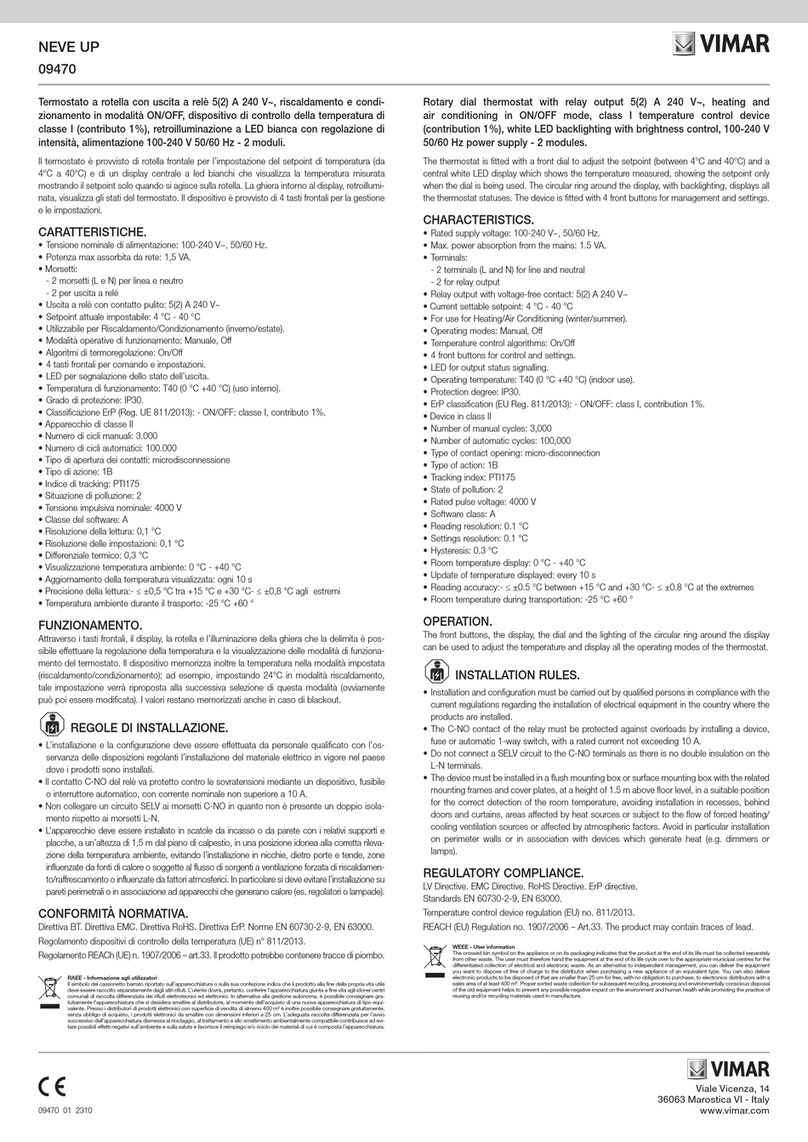
Vimar
Vimar NEVE UP 09470 User manual
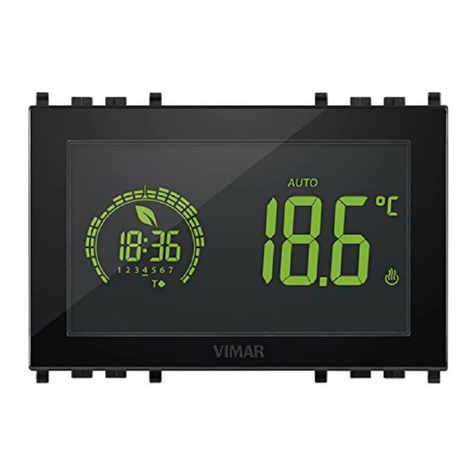
Vimar
Vimar 02955 User manual
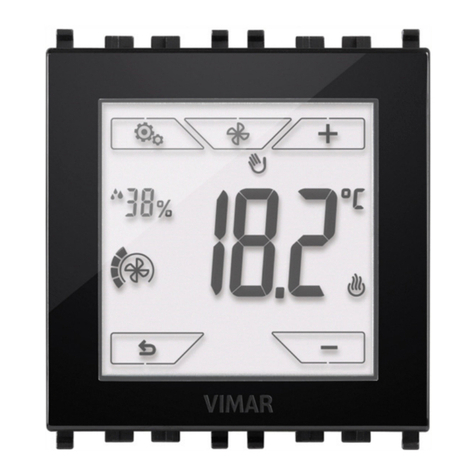
Vimar
Vimar 02952 User guide
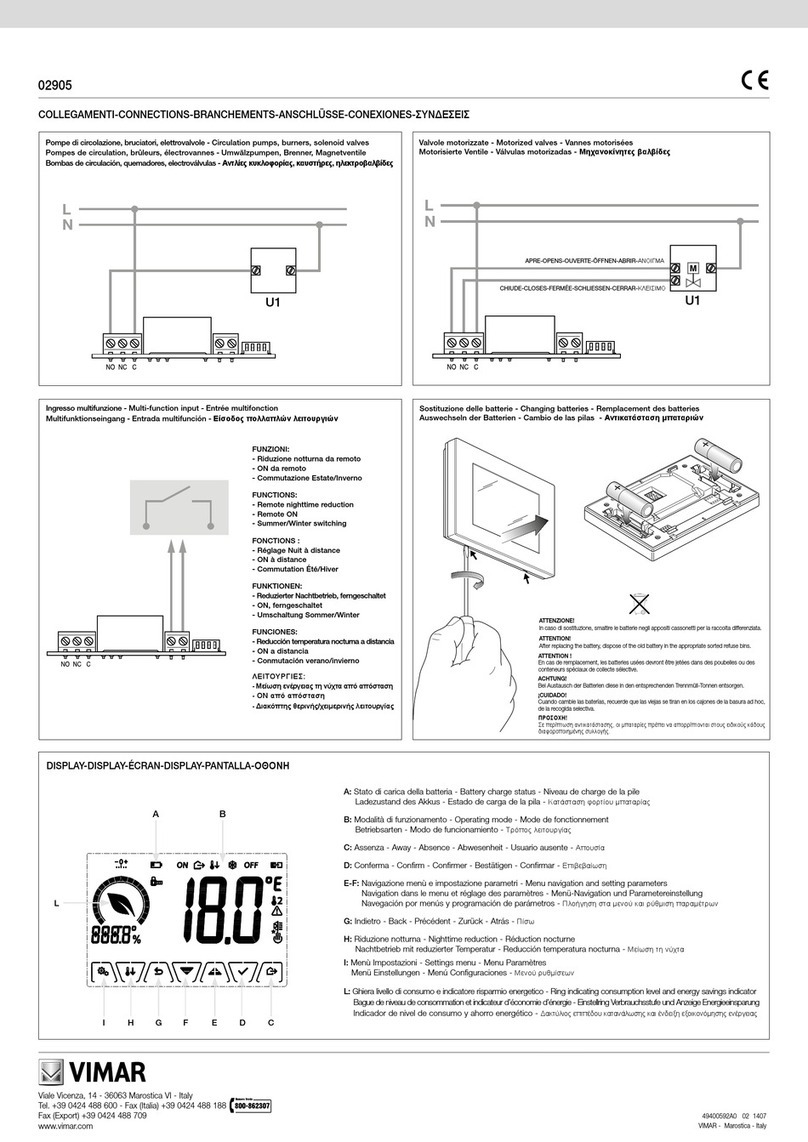
Vimar
Vimar 02905 User manual

Vimar
Vimar 2905 User manual
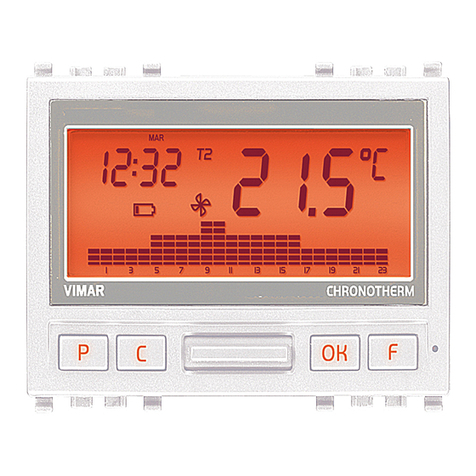
Vimar
Vimar Eikon 20446 manual
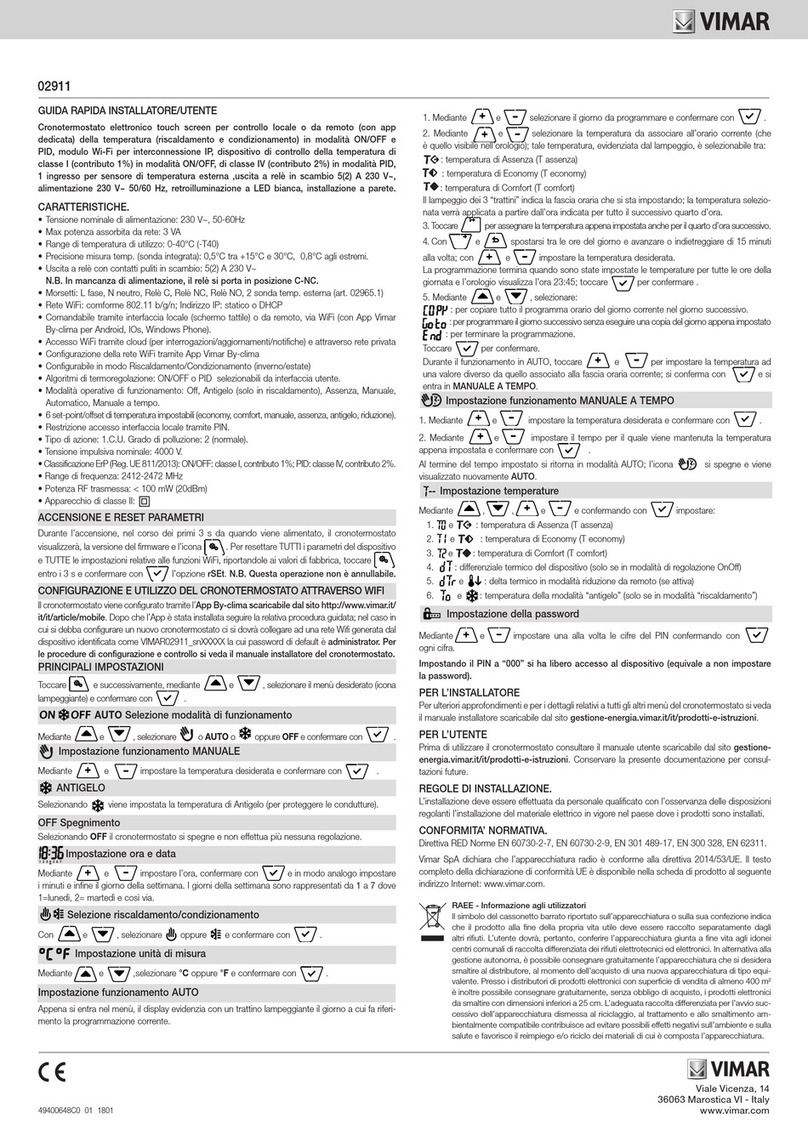
Vimar
Vimar 2911 User manual
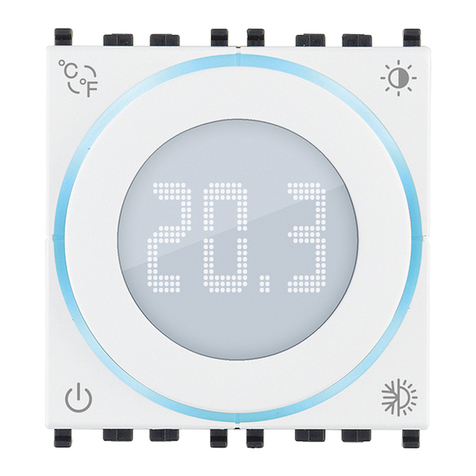
Vimar
Vimar SMART HOME VIEW WIRELESS 02973 User manual
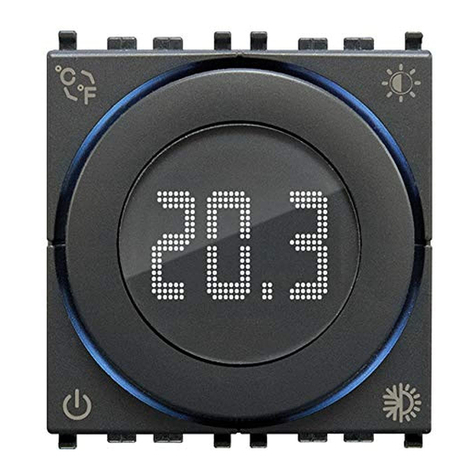
Vimar
Vimar SMART CLIMA User manual
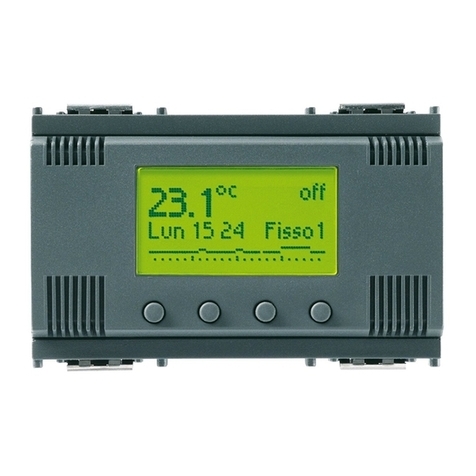
Vimar
Vimar Idea 1657 Series manual
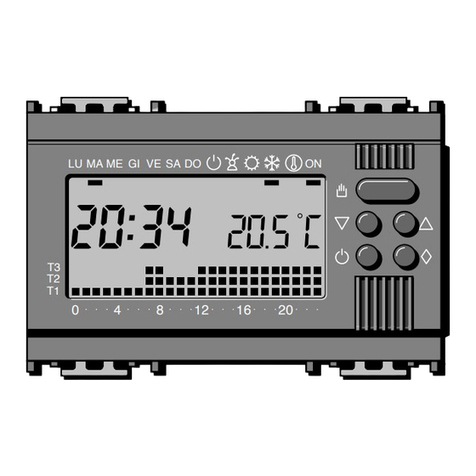
Vimar
Vimar Idea 16577 Manual
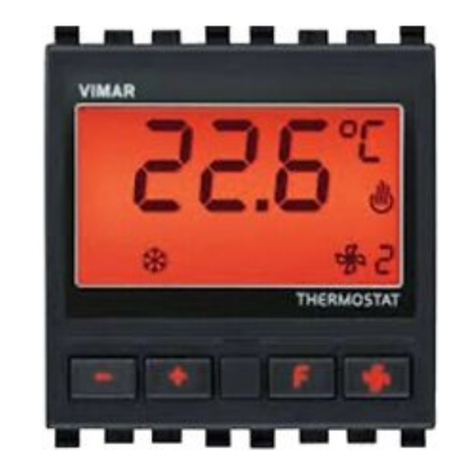
Vimar
Vimar Eikon 20440 manual
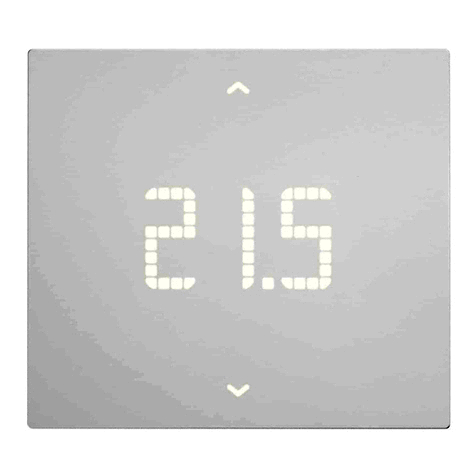
Vimar
Vimar SMART CLIMA 02912 User manual
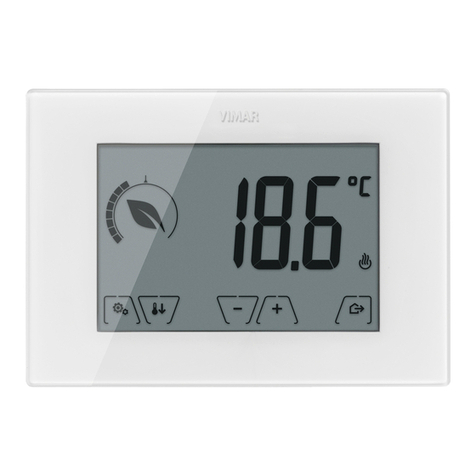
Vimar
Vimar 2905 User manual
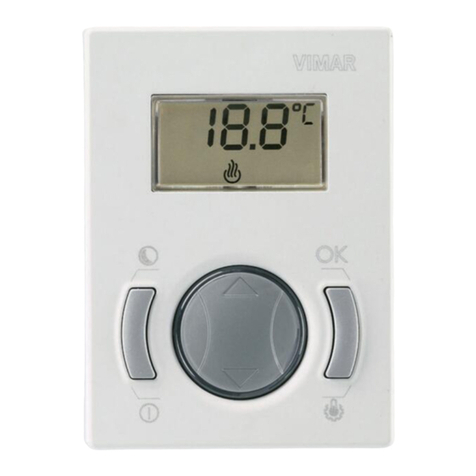
Vimar
Vimar CLIMARADIO manual
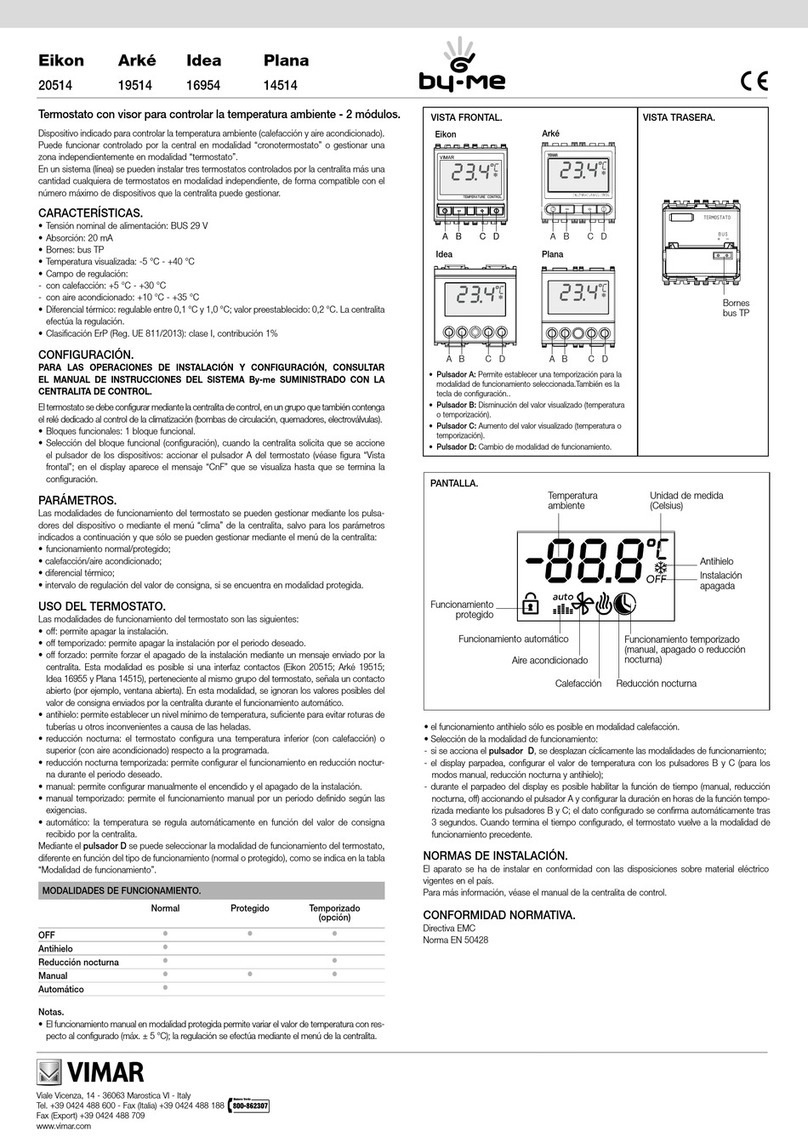
Vimar
Vimar Eikon 20514 User manual
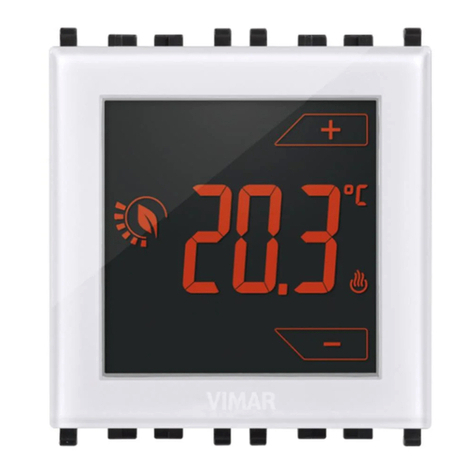
Vimar
Vimar 2950 User manual
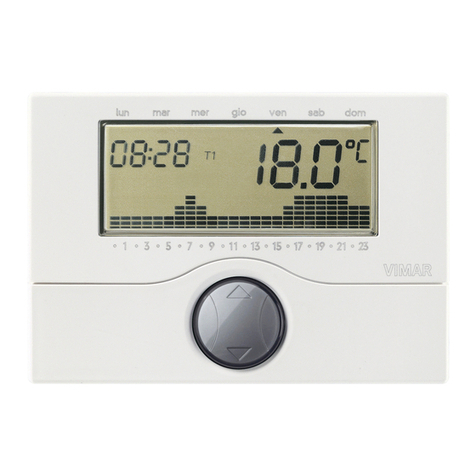
Vimar
Vimar RADIOCLIMA 01910 manual
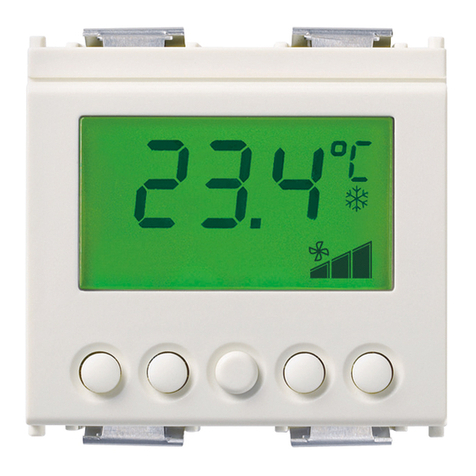
Vimar
Vimar By-me Eikon 20513 User manual
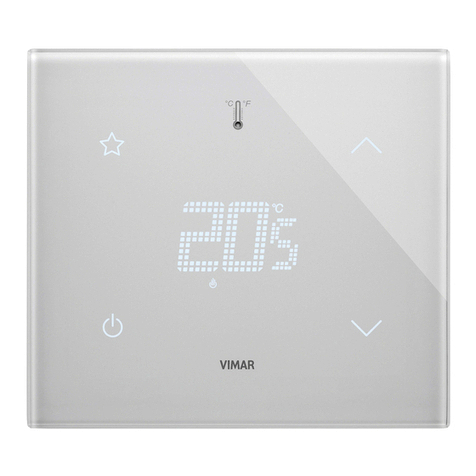
Vimar
Vimar Eikon TACTIL 21814.F User manual
